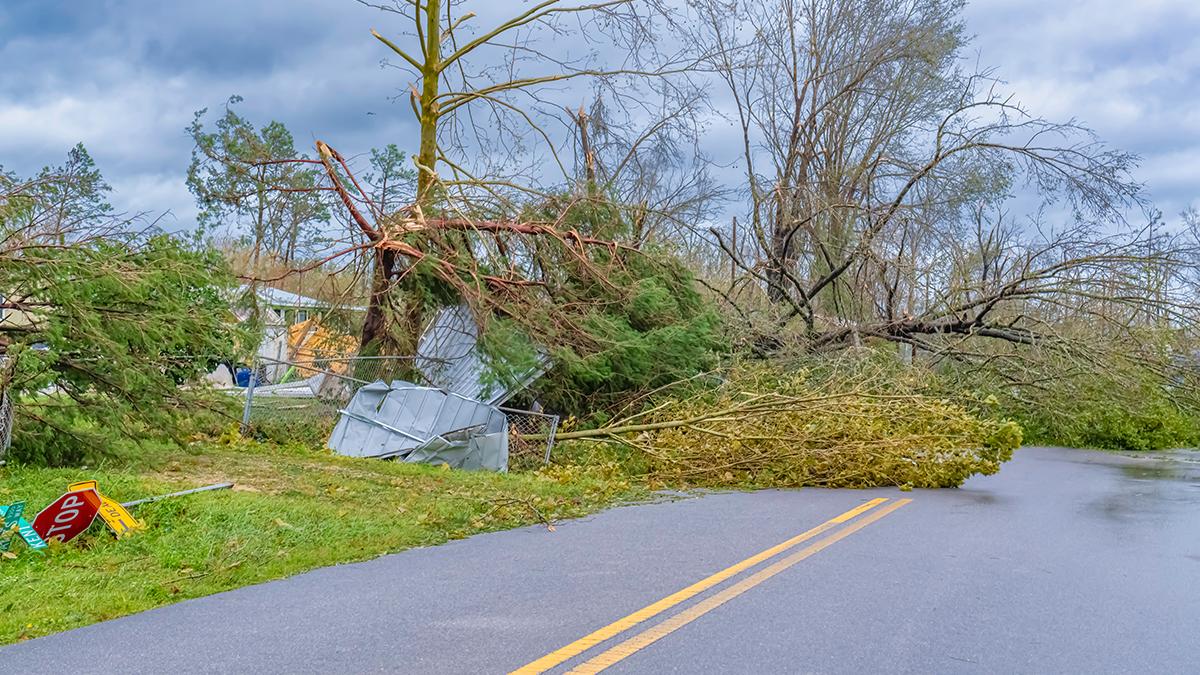
Hurricane Michael has brought down trees in Florida. By terry for Adobe Stock
Researchers at Florida State University and the FAMU-FSU College of Engineering are tackling one of the most pressing environmental challenges facing the Florida Panhandle: wildfires intensified by hurricane debris and vegetation.
FSU’s Department of Computer Science has secured a $2.3 million grant from the National Science Foundation to fund a groundbreaking multidisciplinary initiative that harnesses artificial intelligence tools to better predict, respond to, and recover from these destructive events. The joint college’s RIDER Center is an integral part of the work.
Multidisciplinary Team Addresses Growing Wildfire Threat
Yushun Dong, an assistant professor in FSU’s Department of Computer Science, serves as the principal investigator for the study. The project brings together experts from various departments within the university, including the joint FAMU-FSU College of Engineering’s Resilient Infrastructure and Disaster Response (RIDER) Center, FSU’s Department of Earth, Ocean and Atmospheric Science, Learning Systems Institute, and Stoops Center for Communities, Families, and Children.

A key player and co-investigator in this initiative is Eren Erman Ozguven, an associate professor in the Department of Civil and Environmental Engineering at the joint FAMU-FSU College of Engineering and director of the RIDER Center. He is joined by Mehmet Oztan, director of communications for the center. The RIDER Center specializes in identifying disaster vulnerability in communities across Florida and the Southeast and helps mitigate the negative impacts of natural disasters.
“RIDER is the connection that encompasses the multidisciplinary research team of engineering, computer science, education, earth sciences and social work for this project,” Ozguven emphasized. “Our goal is to save lives and to support communities impacted by the risk of wildfires.”
Hurricane-Wildfire Connection Creates Unique Challenges
The research team is addressing wildfires specifically within the wildland-urban interface—areas where critical infrastructure, such as homes and roads, meet natural landscapes like the Apalachicola National Forest.
“Wildfires are especially critical in hurricane-prone areas like the Panhandle since hurricanes create large amounts of vegetation and debris, which can be highly flammable fuel that can lead to severe wildfires under dry conditions,” Ozguven explains.
Effectively managing wildfires in the Florida Panhandle poses substantial challenges, particularly because hurricanes dramatically alter fire behavior. The economic impact is staggering. According to a 2023 study by the U.S. Congress Joint Economic Committee, wildfires cost the United States between $394 to $893 billion in economic costs and damages annually.
“As of today, more than 2,500 wildfires have burned in 2025 in Florida and as I am writing these lines, there are four active wildfires in Florida’s panhandle,” Ozguven continued.
Comprehensive AI System Targets Full Wildfire Lifecycle
The project, titled “FIRE: An Integrated AI System Tackling the Full Lifecycle of Wildfires in Hurricane-Prone Regions,” aims to develop a comprehensive framework that integrates various scientific disciplines. The researchers are developing an open-source system that will be deployable across the hurricane-affected southeastern United States, potentially transforming wildfire risk management for millions of residents while establishing new standards for interdisciplinary disaster science.
“Our research will create the first comprehensive artificial intelligence system specifically designed to address hurricane-fueled wildfire dynamics throughout the complete wildfire lifecycle,” Ozguven said. “Our focus is on training emergency personnel and educating communities about wildfire risks.”
The AI system focuses on four critical areas of wildfire management:
Pre-Wildfire Preparation – Before a wildfire occurs, the team will use specialized AI tools to predict how and where fires might start from hurricane debris. They will employ spatial-temporal graph neural networks to model hurricane-driven fuel dynamics and physics-informed learning for ignition forecasting.
In-Wildfire Response – During active wildfires, the system will improve evacuation procedures by using crowd-sourced data to anticipate road blockages. The team plans to advance real-time response through AI-enhanced roadway disruption prediction.
Post-Wildfire Assessment – After a wildfire, the AI technology can assess damage to buildings and infrastructure and support recovery planning. The system will use multimodal foundation models for infrastructure damage evaluation and fuel-ecosystem recovery modeling.
Community and Workforce Training – The initiative ensures local emergency teams are prepared and residents understand wildfire dynamics through targeted educational programs and training modules.
Community Partnerships Drive Real-World Impact
Community engagement is a vital aspect of this research. Partners like Tall Timbers and the Apalachee Regional Planning Council are working to ensure that the research translates effectively into real-world applications.
“By partnering with local stakeholders in the Florida Panhandle, we can gather valuable data and implement our solutions effectively, making a real impact through training tools and community engagement,” Ozguven says. “Research outcome can be widely disseminated through deployable tools, educational modules, and community partnerships.”
“We’re partnering with local organizations in the Florida Panhandle to gather important field data and put our research into action,” Oztan said. “The results will be shared widely through practical tools, educational programs, and strong community connections.”
Experts such as Jie Sun, a postdoctoral researcher from the Department of Earth, Ocean and Atmospheric Science, and James Reynolds, co-director of STEM outreach from FSU’s Learning Systems Institute, are co-investigators for the project. Rabieh Razzouk and Rob Lengacher from LSI will be contributing to the project as well as Ellen Piekalkiewicz from the Stoops Center. Their expertise is vital to addressing specific areas of need.
NSF FIRE Program Funds Innovative Wildfire Research
The project is funded as part of an NSF program, Fire Science Innovations through Research and Education, or FIRE, which was established in 2024 and funds research and education enabling large-scale, interdisciplinary breakthroughs that realign our relationship with wildland fire and its connected variables.
By developing innovative AI-driven solutions, this multidisciplinary team at FSU aims to create lasting impact in wildfire preparedness, response, and recovery for hurricane-prone regions across the southeastern United States.
Editor’s Note: This article was edited with a custom prompt for Claude Sonnet 4.5, an AI assistant created by Anthropic. The AI optimized the article for SEO discoverability, improved clarity, structure and readability while preserving the original reporting and factual content. All information and viewpoints remain those of the author and publication. This article was edited and fact-checked by college staff before being published. This disclosure is part of our commitment to transparency in our editorial process. Last edited: 10-11-2025.
RELATED ARTICLES
RIDER Center Partners in $28.7M Grid Resilience Project
New RIDER Center provides technology hub for resilient infrastructure and disaster response
